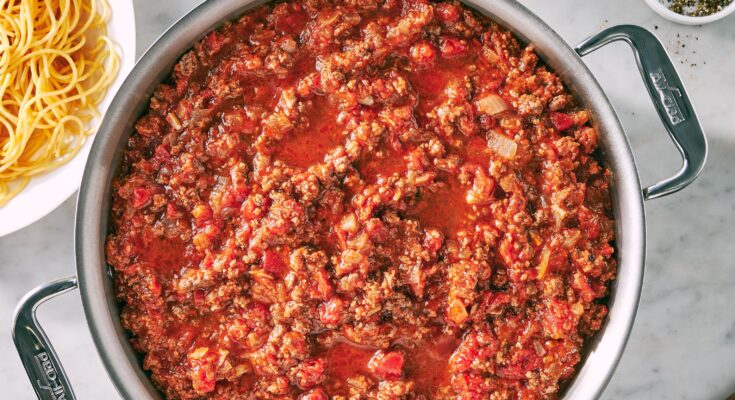Best Spaghetti Sauce Recipe: There’s something magical about making spaghetti sauce from scratch. Store-bought versions may offer convenience, but they often lack the depth, richness, and personal touch that a homemade version provides. When you cook your own sauce, you’re not just feeding your body—you’re nourishing your soul. Plus, you get full control over the ingredients. No weird preservatives, no excessive sugars, and absolutely no compromises. You get to decide how tangy, spicy, or savory you want it. It’s customizable comfort in a pot.
Homemade spaghetti sauce also allows you to experiment and develop your signature flavor. Want it bold and garlicky? Go for it. Love a hint of basil or a kick of chili? Toss it in. Unlike the one-size-fits-all jars on grocery shelves, this sauce becomes uniquely yours. And when it comes to impressing friends or family, few things do it better than a bubbling pot of sauce made from scratch.
A Quick Look at What You’ll Need
Before diving into the full recipe, it helps to know what tools and ingredients you’ll need. Here’s a quick checklist:
- Tools: Large pot or Dutch oven, wooden spoon, sharp knife, cutting board, measuring cups/spoons
- Time: About 1.5 to 2 hours
- Skill Level: Beginner-friendly
With the basics covered, it’s time to gather the ingredients and get cooking.
Ingredients You’ll Need
Core Ingredients
Let’s start with the essentials. These ingredients form the foundation of a rich, flavorful spaghetti sauce:
- Olive oil – For sautéing and adding richness
- Garlic (4-6 cloves) – Fresh, minced for full flavor
- Yellow onion (1 large) – Diced, brings sweetness and depth
- Crushed tomatoes (28 oz can or 4-5 fresh) – The heart of your sauce
- Tomato paste (2 tbsp) – Intensifies the tomato flavor
- Salt and pepper – Basic seasonings to taste
- Italian seasoning (1 tbsp) – A blend of oregano, basil, thyme
- Red pepper flakes (optional, ½ tsp) – For a bit of heat
- Bay leaf (1) – Adds an aromatic layer
- Water or broth (½ cup) – Helps control consistency
Each of these ingredients has a role. Skip one, and the sauce might feel like it’s missing something.
Optional Add-Ins for Enhanced Flavor
If you want to go beyond the basics, try adding these:
- Ground beef, pork, or Italian sausage (1 lb) – For a meat-based sauce
- Fresh basil or parsley (a handful) – Added at the end for freshness
- A splash of red wine (¼ cup) – Adds richness and a subtle bite
- Sugar (1 tsp) – Balances acidity, especially useful with canned tomatoes
- Mushrooms or bell peppers – Sautéed for extra depth
These extras help take the sauce from “pretty good” to “wow, can I get the recipe?”
Step-by-Step Cooking Instructions
Step 1 – Prepping the Ingredients
Before you even turn on the stove, do all your chopping and measuring. Dice the onions, mince the garlic, measure out your spices and liquids. If you’re using meat, get it out and ready to go. This “mise en place” approach saves time and keeps the cooking process smooth. It also helps prevent overcooking or burning ingredients while you scramble to find the next thing.
Step 2 – Sautéing the Aromatics
Heat 2 tablespoons of olive oil in your pot over medium heat. Once it’s shimmering, toss in your diced onions. Let them cook for about 5-7 minutes until they become translucent and slightly golden. Stir frequently so they don’t burn.
Add in the minced garlic and cook for another 1-2 minutes. Garlic cooks quickly, so keep a close eye on it. This step sets the flavor foundation. The aroma alone will make your kitchen smell like an Italian trattoria.
Step 3 – Browning the Meat (Optional)
If you’re making a meat sauce, now’s the time to add your ground beef, pork, or sausage. Crumble it into the pot and cook until it’s fully browned, about 7-10 minutes. Drain any excess fat unless you want a richer sauce. Season lightly with salt and pepper.
This step not only adds heartiness but also builds flavor through browning—a crucial cooking technique known as the Maillard reaction. Sounds fancy, but it’s basically the science behind that savory, craveable taste.
Step 4 – Simmering the Sauce
Now for the most rewarding part—letting the sauce simmer into a masterpiece. Add your crushed tomatoes, tomato paste, a splash of water or broth, bay leaf, and all your seasonings (Italian herbs, red pepper flakes, salt, pepper). If you’re using wine, pour it in now to deglaze the pan and bring out bold, rich undertones.
Stir everything together and bring it to a gentle boil. Once bubbling, reduce the heat to low, partially cover the pot, and let it simmer for at least 45 minutes—an hour or more is even better. Stir occasionally to prevent sticking. As it simmers, the flavors meld, the sauce thickens, and you end up with a deep, complex flavor that’s impossible to rush.
During this phase, taste and adjust the seasoning. A bit more salt? Maybe a pinch of sugar to mellow the acidity? You’re in control here.
Step 5 – Finishing Touches and Taste Testing
About 5 minutes before turning off the heat, remove the bay leaf and stir in any fresh herbs like basil or parsley. Fresh herbs brighten the sauce and give it that homemade feel.
Taste one last time. Is it tangy enough? Rich enough? Add a bit of olive oil for extra silkiness or a splash of cream if you want a rosé-style sauce. Then let the sauce rest for about 10 minutes with the heat off. This gives the flavors a moment to settle and makes your sauce even more delicious when served.
This step ensures you serve a well-balanced, full-bodied spaghetti sauce. Your kitchen should smell heavenly by now.
Tips for Perfect Spaghetti Sauce Every Time
Cooking Low and Slow
The magic word with spaghetti sauce is patience. The longer it cooks, the more the flavors develop. Don’t rush the simmering process—this isn’t fast food. Even if you’re tempted to crank up the heat, resist. Low and slow cooking breaks down the tomatoes, tenderizes any meat, and gives all the spices and herbs time to infuse beautifully.
Also, keep the lid partially on to prevent too much evaporation while still allowing the sauce to thicken. If the sauce gets too thick, just add a little broth or water to loosen it up again.
Balancing Acidity and Sweetness
Tomatoes can be quite acidic, especially canned ones. If your sauce tastes a little too sharp or tart, a small spoonful of sugar can work wonders. Alternatively, you can add a grated carrot during the simmer—it naturally sweetens the sauce without added sugar.
On the flip side, if the sauce feels too flat or sweet, try adding a splash of vinegar or a bit more tomato paste to bring back balance. Cooking is like chemistry with a dash of art. Once you find your balance, you’ll know exactly how to tweak the recipe every time.
Serving Suggestions and Pairings
Best Pasta Types to Pair With
While spaghetti is the obvious choice (it’s in the name, after all), your homemade sauce doesn’t have to be limited to just one noodle type. Here are a few other pasta options that complement this rich, flavorful sauce beautifully:
- Spaghetti – The classic pairing, great for any meat or vegetarian sauce.
- Fettuccine – A thicker noodle that holds up well to a hearty sauce.
- Penne – Tube-shaped pasta that traps sauce inside for an extra burst of flavor with every bite.
- Rigatoni – Larger tubes that are perfect for chunkier sauces or meat-heavy versions.
- Linguine or Tagliatelle – Slightly wider than spaghetti, these are ideal if your sauce has a silky finish.
Cooking your pasta al dente (firm to the bite) is essential. Overcooked noodles absorb too much sauce and lose that beautiful contrast of textures. Be sure to reserve a bit of your pasta water—it helps to thin the sauce if needed and binds everything together with its starchy magic.
Delicious Side Dishes
Want to complete the meal and make it feel like a feast? Pair your spaghetti with any of these crowd-pleasers:
- Garlic Bread – Crunchy on the outside, soft inside, and perfect for mopping up extra sauce.
- Caesar Salad – Crisp romaine, parmesan, croutons, and that zesty dressing create a refreshing contrast.
- Caprese Salad – Fresh mozzarella, tomatoes, basil, and a drizzle of balsamic reduction—it’s a light, tangy complement to the hearty pasta.
- Roasted Veggies – Zucchini, bell peppers, and eggplant roasted with olive oil and Italian herbs enhance the rustic vibe.
These sides elevate your spaghetti night into an Italian-style dinner experience. It’s not just about feeding the stomach—it’s about creating a moment to savor.
Storage and Reheating
Freezing and Shelf Life
One of the best things about homemade spaghetti sauce? It stores like a dream. Whether you’re meal prepping or just cooking in bulk, here’s how to store it safely:
- In the Fridge: Store in an airtight container for up to 5 days. Make sure it cools completely before sealing to avoid condensation and spoilage.
- In the Freezer: Portion the sauce into freezer-safe containers or heavy-duty bags. Lay the bags flat for efficient stacking. Properly stored, it’ll last up to 3 months without losing flavor.
To thaw, just place it in the fridge overnight or run the sealed bag under cold water until loosened. Always label your containers with the date so you know what’s fresh.
Best Reheating Methods
When it comes to reheating, low and slow is again your friend. Here’s how to do it right:
- On the Stovetop: Pour the sauce into a pot and reheat over medium-low heat, stirring occasionally. Add a splash of water or broth if it’s too thick.
- In the Microwave: Use a microwave-safe bowl with a lid. Heat in 1-minute intervals, stirring between each round. This prevents uneven heating or drying out.
- In a Slow Cooker: If you’re feeding a crowd, toss it into a slow cooker on low for a few hours. It keeps warm beautifully and continues developing flavor.
Whichever method you choose, avoid overheating or you’ll risk breaking down the texture. A gentle reheating retains all that homemade goodness.
FAQs about Spaghetti Sauce Recipe
Can I make this sauce vegetarian?
Absolutely! Just skip the meat step. You can even add lentils, mushrooms, or tofu for extra texture and protein.
How long can I store it in the fridge?
The sauce lasts about 5 days in the fridge when stored properly in an airtight container.
Can I use canned tomatoes instead of fresh?
Yes, and in many cases, they’re even preferred for their consistency and flavor. Just choose high-quality canned tomatoes.
What spices can I add to customize the flavor?
Try smoked paprika for depth, fennel seeds for a sausage-like flavor, or extra chili flakes for heat.
Is this sauce good for meal prep?
It’s perfect for meal prep. You can freeze portions and use them throughout the month. Just thaw and reheat!
Conclusion
There you have it—the ultimate, foolproof guide to making the best spaghetti sauce right in your own kitchen. It’s simple, satisfying, and oh-so-delicious. Whether you’re feeding a hungry family, cooking for date night, or just treating yourself to a cozy evening in, this sauce has your back. The beauty lies in its flexibility. Start with the base recipe, then tweak and twist it to fit your taste buds.
Making your own spaghetti sauce isn’t just about food—it’s about creating memories, slowing down, and enjoying the process. There’s nothing quite like watching that pot of bubbling red sauce come to life, knowing it’s made from scratch with your own hands. So, go on—grab that apron and start simmering.



